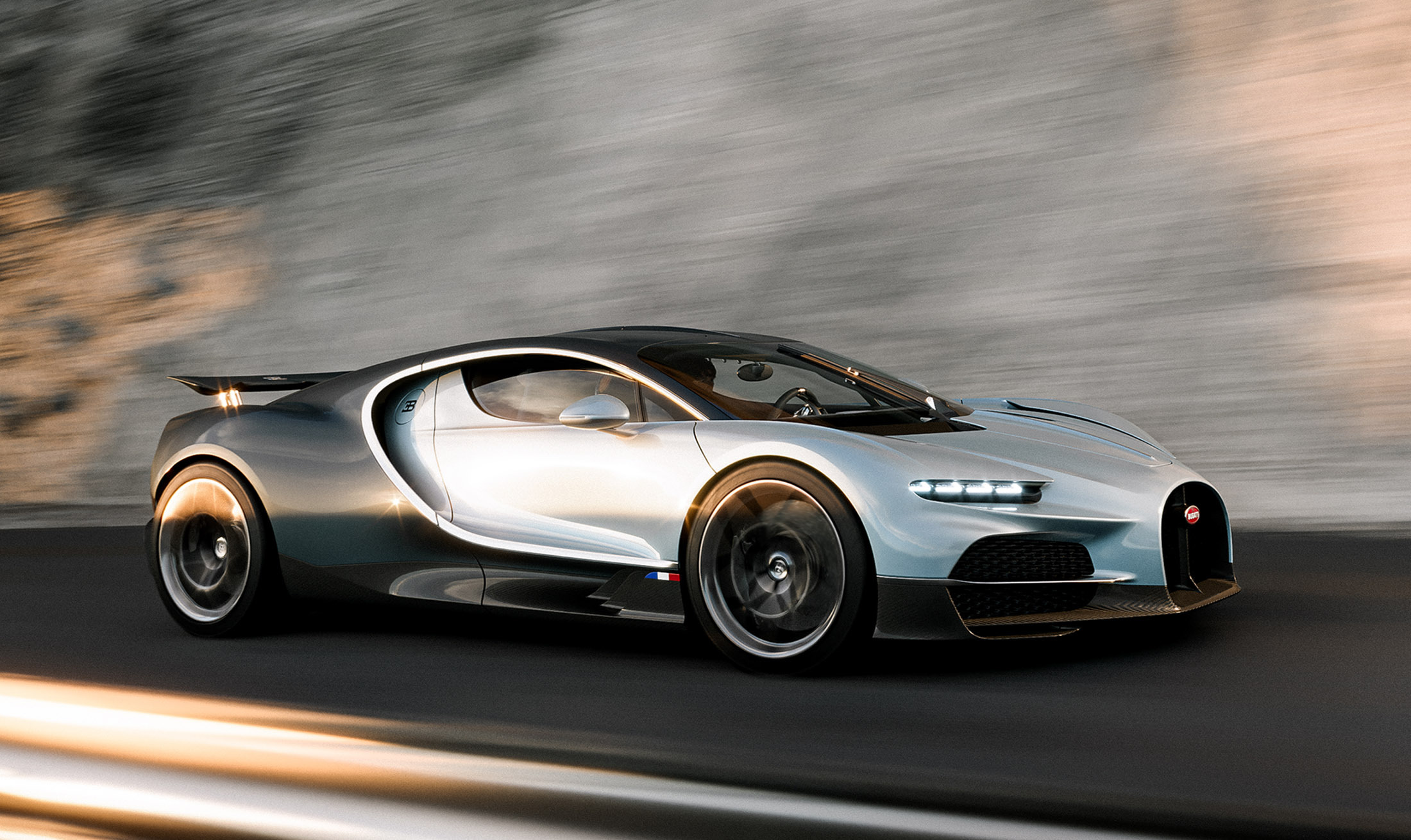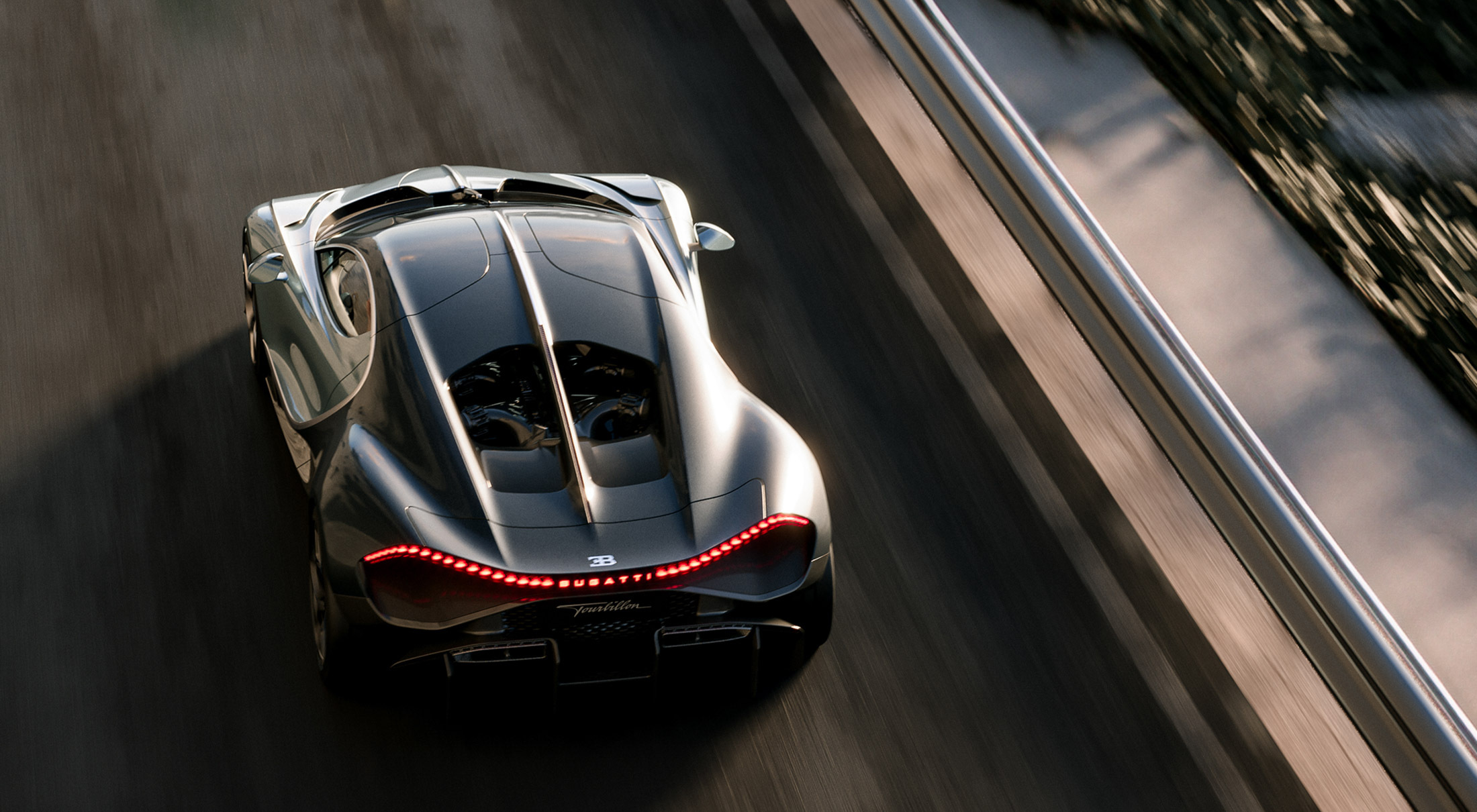- Bugatti has revealed its $4.1m Tourbillion hypercar, a V16 hybrid that replaces the Chiron and is limited to 250 units.
- 986 hp combustion engine is paired with two e-motors on the front axle and one on the rear for a total of 1,775 hp and a 37-mile electric range.
- Tourbillon hits 62 mph (100 km/h) in 2.0 seconds, but reels in the Rimac Nevera EV at higher speeds, reaching 248 mph in less than 25 seconds.
Bugatti’s fightback against the wave of electric and combustion two-seaters that have stolen the Chiron’s performance crown starts here. The automaker’s new Tourbillon is lighter, more powerful and far faster than the hardly-slow hypercar it replaces, plus it’s got the coolest gauge cluster we’ve seen.
We can dig into the design and details later, but let’s get into the engine first, and what it can do. Because this is one engine you’re going to want to know about, and hear in action. Bugatti has junked the 8.0-liter W16 that in various forms has powered every model since the Veyron rebooted the storied brand in 2004. In its place comes an 8.3-liter naturally-aspirated Cosworth-designed V16 that spins to 9,000 rpm.
Related: Bugatti Says It’ll Build A Gas Station At Your House If It Has To
The electric experts at Rimac, who took control of Bugatti in 2021, decided against going full-EV with the Tourbillon, but they have used their know-how to create a three-motor hybrid setup that almost doubles the overall horse count and delivers a 37-mile (60 km) electric-only range.
The V16 alone makes a mighty 986 hp (1,000 hp), virtually matching the output of the original Veyron’s W16 (987 hp / 1,001 PS), but does it without the help of four turbos. What was enough 20 years ago is Little League today, though, so the Tourbillon’s hybrid system tops that up to the tune of 789 hp (800 PS).
And unlike previous modern-era Bugattis this is one that really can sing. The old W16 cars were great at bending physics, but sounded pretty dull. The new V16 makes a noise like a nitrous-injected chainsaw as it chews through revs on its way to generating a total of 1,775 hp (1,800 PS) and an unspecified, but presumably enormous, amount of torque.
That’s not a huge leap over the 1,479 hp (1,500 PS) generated by the regular Chiron or 1,578 hp (1,600 PS) of the Chiron Super Sport. But the performance figures show that Bugatti has definitely moved the game on.
How fast?!
According to Bugatti’s official data the Tourbillon is 0.4 seconds faster to 62 mph (100 km/h) than the original Chiron, getting there in 2 seconds dead. But at that point it’s only just getting into its stride. By 186 mph (300 km/h,) which it reaches in ‘less than’ 10 seconds, or roughly the same time an ordinary small SUV needs to hit 60 mph, it’s pulled out a 3-4-second gap on its predecessor.
Performance
And from there things just get silly, the Tourbillon hitting 248 mph (400 km/h) in ‘less than’ 25 seconds. The Chiron needed 32.6 seconds to do the same, and Rimac’s record-breaking Nevera asks 21.3 seconds. You can hear the Tourbillon pull through the gears in the video of the gauge cluster below, and unless Bugatti has sped up the footage, it looks like the official numbers are very conservative.
The default top speed is 236 mph (380 km/h), the same the Chiron achieved, but while inserting the second ‘speed key’ into the older car upped the limiter to 261 mph (420 km/h), doing the same in the Tourbillon will let the speed run on to 277 mph (445 km/h).
Hypercar meets horology
Those huge speeds are displayed on a stunning gauge cluster that looks like something dreamed up by a watch fanatic with a passion for early 1990s superbikes, and helps explain the name of Bugatti’s new car. A tourbillon is a device invented in 1801 that’s still added to seriously high-end timepieces, including the $170k+ optional clock in the Bentley Bentayga, to increase accuracy.
The Bugatti doesn’t actually appear to have a tourbillon clock, but what matters here is the statement it’s making about technology that lasts. While every other automaker, including Porsche is jumping on the trend for fully digital dashboards that look great now, but will look embarrassingly outdated – if they still work at all – in 30 years, Bugatti is trying to create something timeless.
Which is why the five-dial gauge cluster, whose combined speedo-tacho focal point sits alongside a power dial showing both ICE and electric outputs, is an almost entirely anolog affair. The sole concession to our digital age is a small speed display at the base of the binnacle.
Secret screen
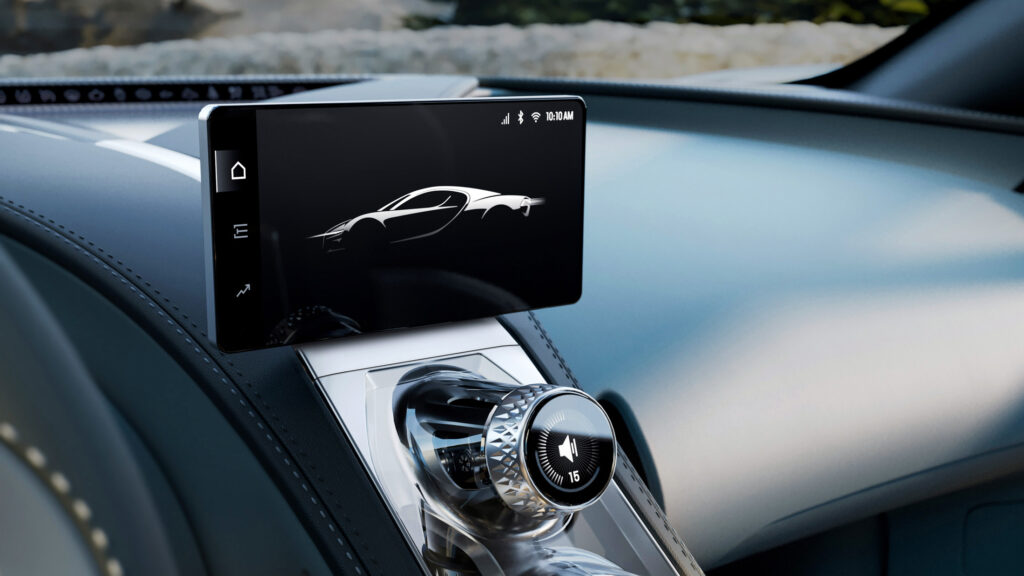
But hit reverse in the eight-speed dual-clutch transmission and in two seconds a portrait screen emerges from the top of the dash to show what’s happening behind you. Or you can summon it independently and, in five seconds, you have a conventional landscape display with full Apple CarPlay access.
The rest of the interior, looks much like the Chiron’s but features some very neat details. One is the knob on the console that you use to fire up the Tourbillon that tips a hat to early 20th century classics. Tugging on it fires up the V16, and pushing it kills it. The electrically adjustable pedal box (the seats are fixed) is another highlight, but easily the most interesting is the steering wheel.
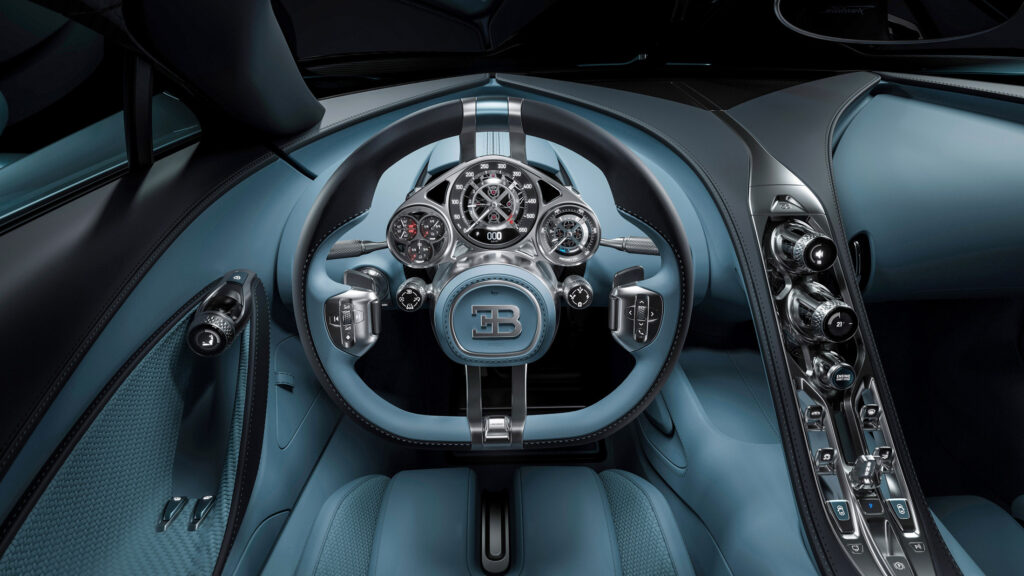
Like the one on BMW’s recent Neue Klasse X SUV concept, it has two spokes mounted at 6- and 12 o’clock. But what really makes it unusual is the fixed hub and the fact that the spokes are mounted behind the gauge pack, meaning the Bugatti ‘B’ always remains upright, and the driver’s view of the instruments is never blocked by the spokes.
More different than it looks
We’ve left the exterior until last because, well, you can look at the pictures and make your own mind up about whether you like it or not. And because, in our opinion, while handsome, and an elegant evolution in the mould of Porsche 911 updates, it doesn’t quite move the game on in the way the engine and interior detail does.
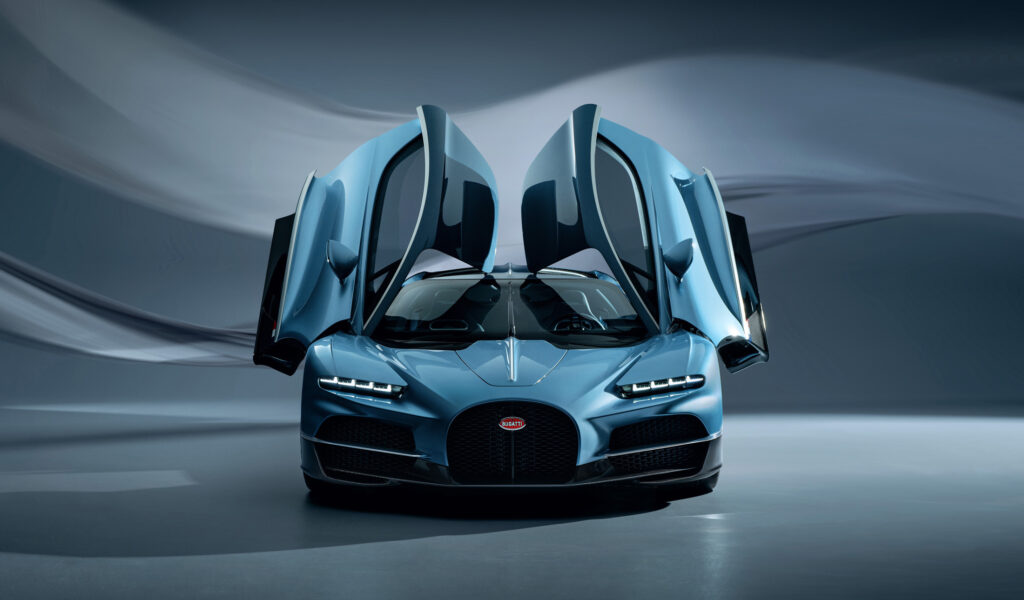
That’s not to say there aren’t some nice surprises here. The doors are now of the dihedral kind, rather than opening like a boring sedan’s, adding some much-needed curbside theater, and feature a Miura-esque (or is it Skoda Yeti?) upward flick at the B-pillar. And the spine that runs from the nose to tail is now more pronounced, and includes a windshield wiper positioned dead-center, like a Le Mans car’s.
The horseshoe snout is also exaggerated, borrowing from the W16 Mistral by way of a cold war fighter jet and a railway tunnel, and the Bugatti name on the tail is illuminated and incorporated into the segmented strip of LED lights that follows the upper contour of the tail. A tail that will look suspiciously familiar to anyone who’s ogled the ass-end of a McLaren P1.
Lighter than a Chiron
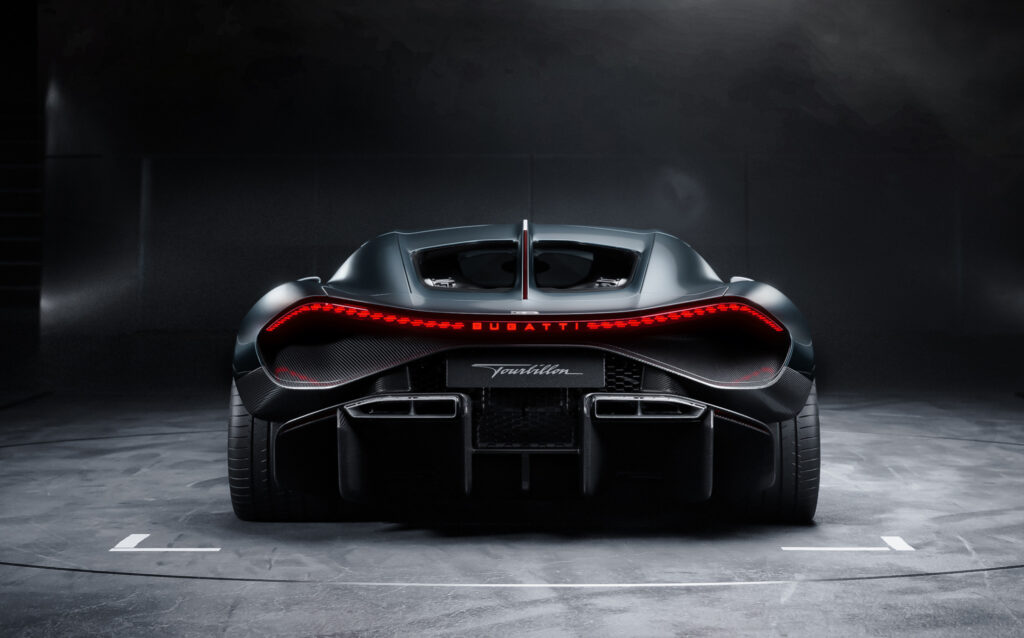
Even the P1 didn’t pack a rear diffuser this big, but then the Tourbillon needs some serious ground-effects tech to keep it stable at its high speed because the active wing remains flush with the body during high speed runs to reduce drag. It only comes out to boost downforce at (comparatively) lower speeds, or to function as an airbrake.
Although the design is evolutionary, Bugatti claims the Tourbillon’s chassis and body structure is all new. The 25 kWh battery is built into the carbon monocoque, and more diet tricks including making the diffuser part of the crash structure and swapping the steel double wishbones for forged aluminium result in the Tourbillon weighing the same 4,400 lbs (1,995 kg) as the Chiron despite its added hybrid tech.
Fewer cars, bigger price
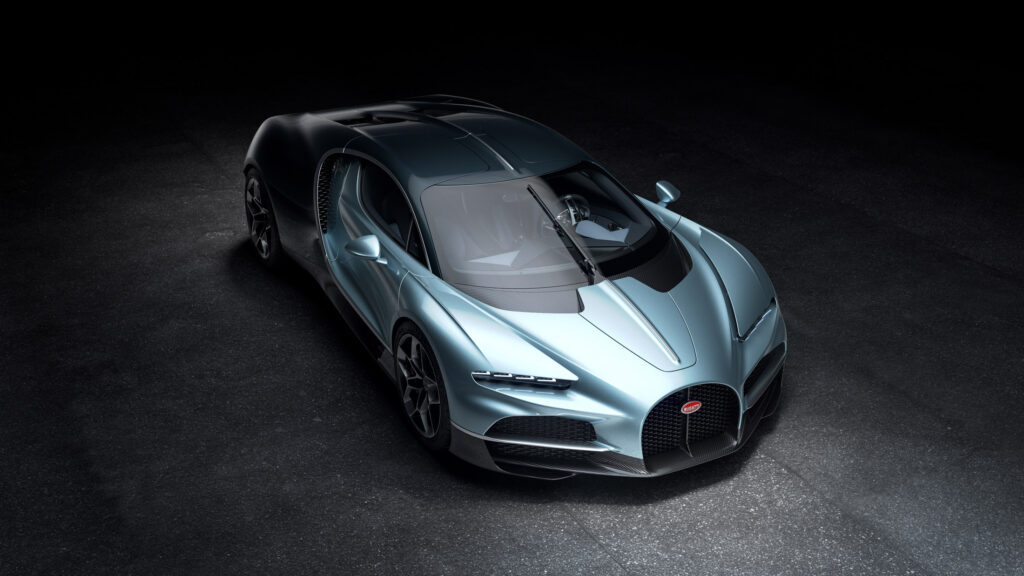
Bugatti built 500 Chirons, the final car rolling off the Molsheim line in May, nine years after the car was first revealed in 2015. But the Tourbillon will be twice as rare. Production is limited to 250 units, with testing already underway and the first customers scheduled to get their cars in 2026.
Not that those billionaire customers will likely care, but that exclusivity comes at a price, one that’s even more more outrageous than the one attached to the Chiron. Bugatti’s departing hypercar cost $3.3 million at the end of its life in the US, but the Tourbillon’s €3.8 million plus taxes Euro price will probably translate to $4.5 million or more by the time it’s on your driveway, and that’s if you haven’t requested any personal touches.
Though they’re great to drive and far more nimble than you might imagine, the Chiron and Veyron before it got plenty of hate for being too heavy and not as pure, analog and exciting as less powerful, less expensive supercars. But the Tourbillon fights back. It says no thanks to fashionable digital tech and no thanks to laggy, sound-sapping turbochargers, instead giving us the only naturally-aspirated V16 fitted to any new car.
Some things don’t change, through. Show it a stretch of runway and a stopwatch and this Bugatti still blows every single rival into the weeds.





